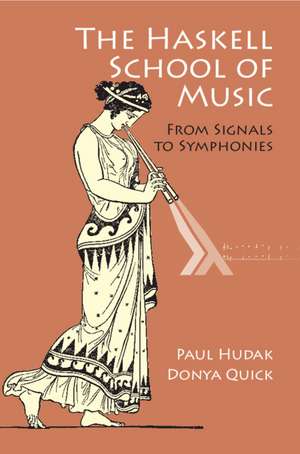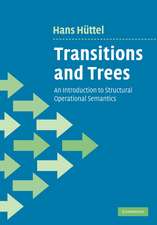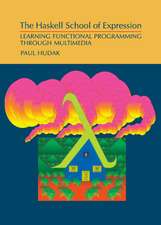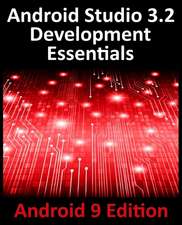The Haskell School of Music: From Signals to Symphonies
Autor Paul Hudak, Donya Quicken Limba Engleză Hardback – 3 oct 2018
Preț: 388.42 lei
Preț vechi: 485.52 lei
-20% Nou
Puncte Express: 583
Preț estimativ în valută:
74.32€ • 77.61$ • 61.37£
74.32€ • 77.61$ • 61.37£
Carte tipărită la comandă
Livrare economică 16-30 aprilie
Preluare comenzi: 021 569.72.76
Specificații
ISBN-13: 9781108416757
ISBN-10: 1108416756
Pagini: 398
Dimensiuni: 156 x 235 x 26 mm
Greutate: 0.66 kg
Editura: Cambridge University Press
Colecția Cambridge University Press
Locul publicării:New York, United States
ISBN-10: 1108416756
Pagini: 398
Dimensiuni: 156 x 235 x 26 mm
Greutate: 0.66 kg
Editura: Cambridge University Press
Colecția Cambridge University Press
Locul publicării:New York, United States
Cuprins
1. Computer music, Euterpea, and Haskell; 2. Simple music; 3. Polymorphic and higher-order functions; 4. A musical interlude; 5. Syntactic magic; 6. More music; 7. Qualified types and type classes; 8. From music to MIDI; 9. Interpretation and performance; 10. Self-similar music; 11. Proof of induction; 12. An algebra of music; 13. L-Systems and generative grammars; 14. Random numbers … and Markov chains; 15. Basic input/output; 16. Higher-order types and monads; 17. Musical user interfaces; 18. Sound and signals; 19. Euterpea's signal functions; 20. Spectrum analysis; 21. Additive and subtractive synthesis; 22. Amplitude and frequency modulation; 23. Physical modeling.
Recenzii
'The selection of material is coherent and satisfying, and the book would be suitable for anyone with an interest in computer music, regardless of programming background.' Henrik Nilsson, University of Nottingham
'Paul Hudak was both a world-leading functional programmer, and skilled jazz musician. This book brings together his two passions, by using Haskell as a domain-specific language for describing music. The result is a fascinating study in how computer science can illuminate art, and art can illuminate computer science.' Simon Peyton Jones, Microsoft Research
'This book is a joy. It should be in the library of every Haskell programmer and every musicologist interested in the underlying mathematics of music. Conceived and written by Paul Hudak, it was brought to fruition by Donya Quick. A fitting tribute to Paul and his lifetime's interests in both Haskell and music.' Richard Bird, University of Oxford
'Programming is the most direct and unrestricted way to tell computers how to behave and what to produce. With this book, the reader will not only learn, step by step, a modern programing language in Haskell, but will also understand how such a language can be tuned towards application in music. This legacy of Paul Hudak is one of the most vibrant and decisive calls for popularizing programming techniques as a new and powerful medium for the arts.' David Janin, University of Bordeaux
'Paul Hudak was both a world-leading functional programmer, and skilled jazz musician. This book brings together his two passions, by using Haskell as a domain-specific language for describing music. The result is a fascinating study in how computer science can illuminate art, and art can illuminate computer science.' Simon Peyton Jones, Microsoft Research
'This book is a joy. It should be in the library of every Haskell programmer and every musicologist interested in the underlying mathematics of music. Conceived and written by Paul Hudak, it was brought to fruition by Donya Quick. A fitting tribute to Paul and his lifetime's interests in both Haskell and music.' Richard Bird, University of Oxford
'Programming is the most direct and unrestricted way to tell computers how to behave and what to produce. With this book, the reader will not only learn, step by step, a modern programing language in Haskell, but will also understand how such a language can be tuned towards application in music. This legacy of Paul Hudak is one of the most vibrant and decisive calls for popularizing programming techniques as a new and powerful medium for the arts.' David Janin, University of Bordeaux
Notă biografică
Descriere
Learn functional programming and the Haskell programming language through algorithmic music composition and virtual instrument design.
























